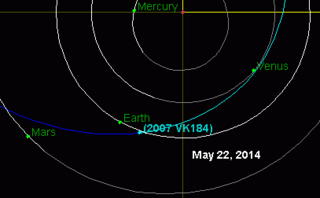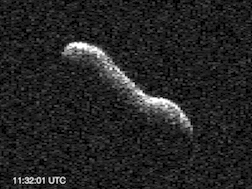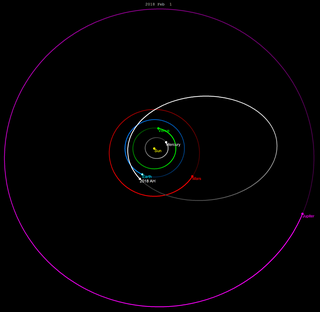1991 BA is a sub-kilometer asteroid, classified as near-Earth object of the Apollo group that was first observed by Spacewatch on 18 January 1991, and passed within 160,000 km (100,000 mi) of Earth. This is a little less than half the distance to the Moon. With a 5-hour observation arc the asteroid has a poorly constrained orbit and is considered lost. It could be a member of the Beta Taurids.

2007 VK184 is a sub-kilometer asteroid, classified as a near-Earth object of the Apollo group, and estimated to be approximately 130 meters (430 ft) in diameter. It was listed on the Sentry Risk Table with a Torino Scale rating of 1 for a potential impactor in June 2048. It was removed from the Sentry Risk Table on 28 March 2014.

A minor planet is "lost" when today's observers cannot find it, because its location is too uncertain to target observations. This happens if the orbital elements of a minor planet are not known accurately enough, typically because the observation arc for the object is too short, or too few observations were made before the object became unobservable.
1994 WR12 is an asteroid and near-Earth object approximately 130 meters (430 feet) in diameter. As a member of the Aten group almost all of its orbit is closer to the Sun than Earth is. On 24 November 1994 it passed about 374100 km from the Moon. First imaged at Kitami Observatory on 26 November 1994, it was discovered two nights later by American astronomer Carolyn S. Shoemaker at Palomar Observatory on 28 November 1994. The asteroid then went unobserved from 1994 until it was recovered by Mauna Kea in March 2016. It was removed from the Sentry Risk Table on 2 April 2016.
(5496) 1973 NA, is a very eccentric and heavily tilted asteroid, classified as near-Earth object of the Apollo group, approximately 2 kilometers in diameter. It was discovered on 4 July 1973, by American astronomer Eleanor Helin at the U.S. Palomar Observatory in California. At the time of its discovery, it was the most highly inclined minor planet known to exist. It may be the parent body of the Quadrantids.

1999 XS35 is a near-Earth object discovered in 1999 having a comet-like orbit. Its semi-major axis is 17.8 AU. Its orbital eccentricity is 0.94, which means that at the perihelion 1999 XS35 comes as close as 0.9 AU to the Sun, while at the aphelion it reaches beyond the orbit of Neptune. 1999 XS35 is a damocloid. 1999 XS35 is a small object with an absolute magnitude (H) of 17.2, which implies a size of about 1 km.
(467336) 2002 LT38, is a sub-kilometer asteroid and suspected tumbler, classified as a near-Earth object and potentially hazardous asteroid of the Aten group, approximately 240 meters (790 ft) in diameter. It was discovered on 12 June 2002, by astronomers of the Lincoln Near-Earth Asteroid Research at the Lincoln Laboratory's Experimental Test Site near Socorro, New Mexico, in the United States.

(367789) 2011 AG5, provisional designation 2011 AG5, is a sub-kilometer asteroid, classified as near-Earth object and potentially hazardous asteroid of the Apollo group. It has a diameter of about 140 meters (460 ft). It was removed from the Sentry Risk Table on 21 December 2012 and as such it now has a rating of 0 on the Torino Scale. It was recovered in December 2022 extending the observation arc from 4.8 years to 14 years. As of 2023, the distance between the orbits of Earth and 2011 AG5 is 0.0004 AU (60,000 km; 0.16 LD)
2010 XC15 (also written 2010 XC15) is an Aten near-Earth asteroid and potentially hazardous object that spends most of its time inside of the orbit of Earth. It has an observation arc of 10 years and an Uncertainty Parameter of 1. It was discovered on 5 December 2010 by the Catalina Sky Survey at an apparent magnitude of 17.5 using a 0.68-metre (27 in) Schmidt.
(31345) 1998 PG is an eccentric, stony asteroid and binary system, classified as near-Earth object of the Amor group of asteroids, approximately 900 meters in diameter. It minor-planet moon, S/2001 (31345) 1, has an estimated diameter of 270 meters.
2011 XC2 (also written 2011 XC2) is a near-Earth asteroid roughly 60–140 meters (200–460 ft) in diameter that passed less than 1 lunar distance from Earth on 3 December 2011.

(388188) 2006 DP14, provisional designation 2006 DP14, is a sub-kilometer sized, peanut-shaped asteroid on a highly eccentric orbit, classified as near-Earth object and potentially hazardous asteroid of the Apollo group. This contact binary was discovered on 23 February 2006, by astronomers of the LINEAR program at the Lincoln Laboratory's Experimental Test Site near Socorro, New Mexico, in the United States. On 10 February 2014, it passed 6.25 lunar distances from Earth. The asteroid is approximately 400 meters in diameter and has a rotation period of 5.77 hours.
2010 GZ60 was originally estimated by JPL to be a near-Earth asteroid approximately 2 kilometers (1.2 miles) in diameter. But is now known to be an asteroid from the inner region of the asteroid belt that does not get closer than 1.5 AU (220 million km) to Earth.

2018 AH is a sub-kilometer asteroid, classified as near-Earth object of the Apollo group, approximately 100 m (300 ft) in diameter. It was first observed on 4 January 2018, by the Asteroid Terrestrial-impact Last Alert System (ATLAS) on Mauna Loa and quickly followed-up by many other surveys, with precovery observations found from Pan-STARRS and PTF from the day previous.

C/2018 F4 (PanSTARRS) is a hyperbolic comet. It was discovered on 17 March 2018 when it was beyond the orbit of Jupiter, 6.4 AU (960 million km) from the Sun. It was quite far from the Sun and turned out to simply be an asteroidal object that was discovered before cometary activity was noticeable. As perihelion is inside the orbit of Jupiter, this object should become more active. In April 2018 it was determined to be a hyperbolic comet. Given that the incoming velocity was similar to that of an Oort cloud object, we can very confidently say that it is not of interstellar origin. C/2018 F4 fragmented around August 2020.

2018 LF16 is a small Mars crossing asteroid roughly 213 m (699 ft) in diameter. It was first observed by astronomers with the Pan-STARRS survey at Haleakala Observatory on 14 June 2018. It was removed from the Sentry Risk Table on 29 July 2021. With an observation arc of 15 years the orbit is very well known and it does not make any notable approaches to Earth.
2020 XR is an Apollo near-Earth object and potentially hazardous asteroid roughly 390 meters in diameter. With a 5-day observation arc it was briefly listed as having a 1 in 11,000 chance of impacting Earth on 1 December 2028 placing it at the top of the Sentry Risk Table with a Palermo scale rating of -0.70.
2020 AP1 is an Apollo near-Earth object roughly 5 meters (20 feet) in diameter. On 2 January 2020 it passed 0.00218 AU (326 thousand km; 0.85 LD) from Earth. With a short 1-day observation arc it was roughly expected to pass about 0.01 AU (1.5 million km; 3.9 LD) from Earth on 7 January 2022, but with an uncertainty of ±8 days for the close approach date it could have passed significantly closer or further.
2022 AE1 is a Tunguska event-sized asteroid, classified as a near-Earth object of the Apollo group, approximately 70 meters (230 feet) in diameter. It was discovered by the Mount Lemmon Survey on 6 January 2022, when it was 0.09 AU (13 million km) from Earth. On 9 January 2022 with an observation arc of 3 days, it was rated with a Torino scale of 1 for a virtual impactor on 4 July 2023 16:28 UTC. Nominal approach is expected to occur 1 July 2023 01:13 ± 1 day. With a Palermo scale rating of as high as –0.66 at the European Space Agency on 11 January 2022, the odds of impact peaked at about 4.6 times less than the background hazard level. NEODyS was the first risk-page to drop to Torino scale 0 on 12 January 2022 followed by ESA on 13 January 2022, but by January 14 both returned to Torino scale 1. On 14 January 2022 the waxing gibbous moon was as little as 3 degrees from the asteroid delaying observations of the asteroid from January 12–19. On 20 January 2022 with a 16-day observation arc, using JPL #11 the Sentry Risk Table dropped the asteroid to Torino scale 0 and then later that day JPL #12 resulted in it being removed from the risk table.








